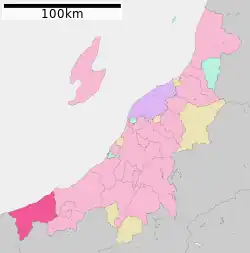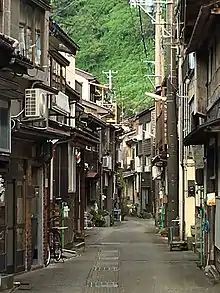Itoigawa
糸魚川市 | ||||||
|---|---|---|---|---|---|---|

| ||||||
 Flag  Seal | ||||||
 Location of Itoigawa in Niigata | ||||||
 Itoigawa | ||||||
| Coordinates: 37°2′20.5″N 137°51′45.6″E / 37.039028°N 137.862667°E | ||||||
| Country | Japan | |||||
| Region | Chūbu (Kōshin'etsu) (Hokuriku) | |||||
| Prefecture | Niigata | |||||
| First official recorded | 100 AD | |||||
| City settled | June 1, 1954 | |||||
| Government | ||||||
| • Mayor | Tōru Yoneda (since April 2005) | |||||
| Area | ||||||
| • Total | 746.24 km2 (288.12 sq mi) | |||||
| Population (December 31, 2020) | ||||||
| • Total | 41,333 | |||||
| • Density | 55/km2 (140/sq mi) | |||||
| Time zone | UTC+9 (Japan Standard Time) | |||||
| Symbols | ||||||
| • Tree | Siebold's beech | |||||
| • Flower | Lilium japonicum | |||||
| • Bird | Common kingfisher | |||||
| • Stone | Jade | |||||
| Phone number | 025-552-1511 | |||||
| Address | 1-2-5 Ichinomiya, Itoigawa-shi, Niigata-ken 941-8501 | |||||
| Climate | Cfa | |||||
| Website | Official website | |||||


Itoigawa (糸魚川市, Itoigawa-shi) is a city located in Niigata Prefecture, Japan. As of 31 January 2020, the city had an estimated population of 41,333, and a population density of 55 persons per km2. The total area of the city is 746.24 square kilometres (288.12 sq mi).[1]
Geography
Itoigawa is located in the far southwestern corner of Niigata Prefecture, bordered by the Sea of Japan to the north, Nagano Prefecture to the south, and Toyama Prefecture to the west. Parts of the city are within the borders of the Chūbu-Sangaku National Park or the Myōkō-Togakushi Renzan National Park. Itoigawa is also famous for its jade which can be found on local beaches. Itoigawa also lends its name to the Itoigawa-Shizuoka Tectonic Line, a major fault that runs from Itoigawa, through Lake Suwa to the city of Shizuoka in Shizuoka Prefecture, forming the western border of the Fossa Magna.
Surrounding municipalities
Climate
Itoigawa has a Humid climate (Köppen Cfa) characterized by warm, wet summers and cold winters with heavy snowfall. The average annual temperature in Itoigawa is 14.4 °C (57.9 °F). The average annual rainfall is 2,901.5 mm (114.23 in) with December as the wettest month. The temperatures are highest on average in August, at around 26.6 °C (79.9 °F), and lowest in January, at around 3.6 °C (38.5 °F).[2] In addition, Itoigawa has the highest record warm daily minimum in Japan, at 31.3 °C (88.3 °F) on August 15, 2019.[3]
| Climate data for Itoigawa (1991−2020 normals, extremes 1978−present) | |||||||||||||
|---|---|---|---|---|---|---|---|---|---|---|---|---|---|
| Month | Jan | Feb | Mar | Apr | May | Jun | Jul | Aug | Sep | Oct | Nov | Dec | Year |
| Record high °C (°F) | 17.5 (63.5) |
23.6 (74.5) |
26.0 (78.8) |
30.7 (87.3) |
31.8 (89.2) |
34.7 (94.5) |
37.2 (99.0) |
39.3 (102.7) |
37.6 (99.7) |
35.1 (95.2) |
27.0 (80.6) |
23.5 (74.3) |
39.3 (102.7) |
| Mean daily maximum °C (°F) | 7.0 (44.6) |
7.4 (45.3) |
10.9 (51.6) |
16.3 (61.3) |
21.2 (70.2) |
23.4 (74.1) |
28.5 (83.3) |
30.3 (86.5) |
26.6 (79.9) |
21.3 (70.3) |
15.7 (60.3) |
10.2 (50.4) |
18.3 (64.9) |
| Daily mean °C (°F) | 3.6 (38.5) |
3.8 (38.8) |
6.7 (44.1) |
11.8 (53.2) |
16.8 (62.2) |
20.7 (69.3) |
25.0 (77.0) |
26.6 (79.9) |
22.8 (73.0) |
17.3 (63.1) |
11.6 (52.9) |
6.5 (43.7) |
14.4 (57.9) |
| Mean daily minimum °C (°F) | 0.9 (33.6) |
0.7 (33.3) |
2.9 (37.2) |
7.6 (45.7) |
12.9 (55.2) |
17.7 (63.9) |
22.3 (72.1) |
23.6 (74.5) |
19.7 (67.5) |
14.0 (57.2) |
8.2 (46.8) |
3.4 (38.1) |
11.2 (52.2) |
| Record low °C (°F) | −5.3 (22.5) |
−5.2 (22.6) |
−3.1 (26.4) |
−1.3 (29.7) |
5.1 (41.2) |
10.7 (51.3) |
15.4 (59.7) |
17.2 (63.0) |
11.4 (52.5) |
4.8 (40.6) |
0.8 (33.4) |
−4.2 (24.4) |
−5.3 (22.5) |
| Average precipitation mm (inches) | 354.8 (13.97) |
225.5 (8.88) |
204.5 (8.05) |
135.1 (5.32) |
120.5 (4.74) |
168.0 (6.61) |
237.8 (9.36) |
223.3 (8.79) |
251.4 (9.90) |
232.4 (9.15) |
341.0 (13.43) |
407.4 (16.04) |
2,901.5 (114.23) |
| Average precipitation days (≥ 1.0 mm) | 24.8 | 19.8 | 18.9 | 13.2 | 11.4 | 11.8 | 14.2 | 11.7 | 14.0 | 15.2 | 19.1 | 23.4 | 197.5 |
| Mean monthly sunshine hours | 52.9 | 85.2 | 135.4 | 178.8 | 205.3 | 160.4 | 159.2 | 195.2 | 138.9 | 133.9 | 99.7 | 66.6 | 1,611.5 |
| Source 1: 理科年表 | |||||||||||||
| Source 2: Japan Meteorological Agency[2][4] | |||||||||||||
Demographics
Per Japanese census data,[5] the population of Itoigawa has declined steadily over the past 70 years and is now less than it was a century ago.
| Year | Pop. | ±% |
|---|---|---|
| 1920 | 58,580 | — |
| 1930 | 63,103 | +7.7% |
| 1940 | 64,019 | +1.5% |
| 1950 | 78,727 | +23.0% |
| 1960 | 77,641 | −1.4% |
| 1970 | 67,785 | −12.7% |
| 1980 | 61,488 | −9.3% |
| 1990 | 56,803 | −7.6% |
| 2000 | 53,021 | −6.7% |
| 2010 | 47,702 | −10.0% |
| 2020 | 40,765 | −14.5% |
History
The area of present-day Itoigawa was part of ancient Echigo Province. Historically, Itoigawa lies at the end of the shio no michi (salt road) that supplied salt from the Sea of Japan to Edo via Shinano Province. During the Edo period, Itoigawa was the castle town for Itoigawa Domain. After the Meiji restoration, with the establishment of the modern municipalities system on April 1, 1889, Itoigawa became a town within Nishikubiki District, Niigata.
The modern city was created on June 1, 1954 when the former town of Itoigawa absorbed the villages of Uramoto, Shimohayakawa, Kamihayakawa, Yamatogawa, Saikai, Ōno (Daino), Nechi and Kotati (Otaki) to elevate city status. On April 1, 2005, the towns of Nō and Ōmi (both from Nishikubiki District) were merged into Itoigawa.
Oldest known jadeite-using culture
A great many jadeite beads and axe heads as well as the remains of jadeite workshops from the Neolithic era have been uncovered in Itoigawa. These beads and axes were traded throughout Japan and the Korean Peninsula and were produced by the world's oldest known jadeite-using culture, centered on the Itoigawa region.[6][7]
Government
Itoigawa has a mayor-council form of government with a directly elected mayor and a unicameral city legislature of 20 members. Itoigawa contributes one member to the Niigata Prefectural Assembly. In terms of national politics, the city is part of Niigata 6th district of the lower house of the Diet of Japan.
Economy
Commercial fishing and the production of limestone and cement are the mainstays of the local economy.
Education
Itoigawa has 14 public elementary schools and four public middle schools operated by the city government, and three public high schools operated by the Niigata Prefectural Bureau of Education. The city and prefecture also operate one special education school each for the handicapped.
Transportation
Railway
![]() Echigo Tokimeki Railway - Nihonkai Hisui Line
Echigo Tokimeki Railway - Nihonkai Hisui Line
- Ichiburi - Oyashirazu - Ōmi - Itoigawa - Kajiyashiki - Uramoto - Nō - Tsutsuishi
Highway
 Hokuriku Expressway – Oyashirazu IC, Itoigawa IC, Nō IC
Hokuriku Expressway – Oyashirazu IC, Itoigawa IC, Nō IC National Route 49
National Route 49 National Route 290
National Route 290 National Route 8
National Route 8 National Route 148
National Route 148
Local attractions
- The entire territory of Itoigawa is "Itoigawa Global Geopark" which is a member of the Japanese Geoparks Network and Global Geoparks Network on account of its outstanding geological heritage, educational programs and projects, and promotion of geotourism.[8]
- The city is known for its distinctive black-colored yakisoba.[9]
- Itoigawa is also known for its unique bugaku, a variety of traditional Japanese performance art. Itoigawa Bugaku can be seen at festivals taking place at Hakusan Shrine and Amatsu Shrine, and has been nationally designated as an Important Intangible Cultural Asset.
National Historic Sites
- Chōjagahara Site, Jōmon period archaeological site
- Terachi Site, Jōmon period archaeological site
- Matsumoto Kaidō, ancient highway
Notable people from Itoigawa
- The poet Ryōkan (1758-1831) writes that Itoigawa is his former village.[10]
- Hideki Hosaka, Japanese professional wrestler (known for his work in Frontier Martial-Arts Wrestling, All Japan Pro Wrestling, and Pro Wrestling Zero-One)
References
- ↑ "Itoigawa official statistics". Itoigawa City. 1 January 2021. Retrieved 3 January 2021.
- 1 2 "平年値(年・月ごとの値)". Japan Meteorological Agency. Retrieved 2012-08-10.
- ↑ 最高気温の低い方から (各地点の観測史上1位の値を使ってランキングを作成)
- ↑ "観測史上1~10位の値(年間を通じての値)". Japan Meteorological Agency. Retrieved 2012-08-10.
- ↑ Itoigawa population statistics
- ↑ Kijima, Tsutomu. 翡翠製大珠の加工と流通 (in Japanese).
- ↑ Pearson, Richard. "International Jomon Culture Conference Bulletin 1 2004 (English version)". Retrieved 2016-06-30.
- ↑ Itoigawa Global Geopark
- ↑ Trautlein, Steve, "The chow-down tour of Kanto's local dishes Archived 2012-09-27 at the Wayback Machine", Japan Times, 24 August 2012, p. 15
- ↑ One Robe, One Bowl; the Zen poetry of Ryokan. transl. John Stevens. 9th Ed. John Weatherhill, Inc., Tokyo. 1988.
External links
- Official Website (in Japanese)